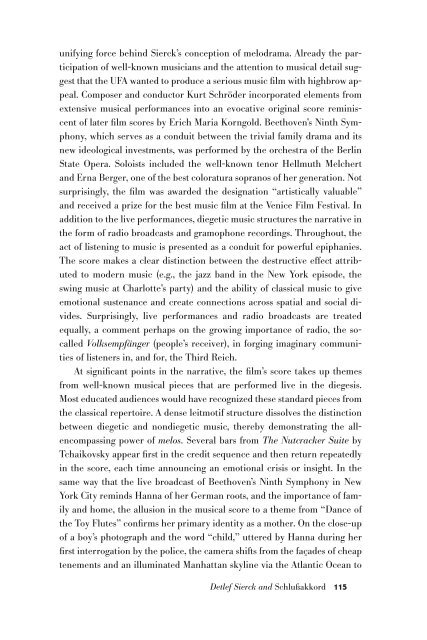You also want an ePaper? Increase the reach of your titles
YUMPU automatically turns print PDFs into web optimized ePapers that Google loves.
unifying force behind Sierck’s conception of melodrama. Already the participation<br />
of well-known musicians and the attention to musical detail suggest<br />
that the UFA wanted to produce a serious music film with highbrow appeal.<br />
Composer and conductor Kurt Schröder incorporated elements from<br />
extensive musical performances into an evocative original score reminiscent<br />
of later film scores by Erich Maria Korngold. Beethoven’s Ninth Symphony,<br />
which serves as a conduit between the trivial family drama and its<br />
new ideological investments, was performed by the orchestra of the Berlin<br />
State Opera. Soloists included the well-known tenor Hellmuth Melchert<br />
and Erna Berger, one of the best coloratura sopranos of her generation. Not<br />
surprisingly, the film was awarded the designation “artistically valuable”<br />
and received a prize for the best music film at the Venice Film Festival. In<br />
addition to the live performances, diegetic music structures the narrative in<br />
the form of radio broadcasts and gramophone recordings. Throughout, the<br />
act of listening to music is presented as a conduit for powerful epiphanies.<br />
The score makes a clear distinction between the destructive effect attributed<br />
to modern music (e.g., the jazz band in the New York episode, the<br />
swing music at Charlotte’s party) and the ability of classical music to give<br />
emotional sustenance and create connections across spatial and social divides.<br />
Surprisingly, live performances and radio broadcasts are treated<br />
equally, a comment perhaps on the growing importance of radio, the socalled<br />
Volksempfänger (people’s receiver), in forging imaginary communities<br />
of listeners in, and for, the Third Reich.<br />
At significant points in the narrative, the film’s score takes up themes<br />
from well-known musical pieces that are performed live in the diegesis.<br />
Most educated audiences would have recognized these standard pieces from<br />
the classical repertoire. A dense leitmotif structure dissolves the distinction<br />
between diegetic and nondiegetic music, thereby demonstrating the allencompassing<br />
power of melos. Several bars from The Nutcracker Suite by<br />
Tchaikovsky appear first in the credit sequence and then return repeatedly<br />
in the score, each time announcing an emotional crisis or insight. In the<br />
same way that the live broadcast of Beethoven’s Ninth Symphony in New<br />
York City reminds Hanna of her German roots, and the importance of family<br />
and home, the allusion in the musical score to a theme from “Dance of<br />
the Toy Flutes” confirms her primary identity as a mother. On the close-up<br />
of a boy’s photograph and the word “child,” uttered by Hanna during her<br />
first interrogation by the police, the camera shifts from the façades of cheap<br />
tenements and an illuminated Manhattan skyline via the Atlantic Ocean to<br />
Detlef Sierck and Schlußakkord 115

















